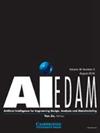基于人工神经网络的鲸鱼优化算法的FDM参数优化
IF 2.3
3区 工程技术
Q3 COMPUTER SCIENCE, ARTIFICIAL INTELLIGENCE
Ai Edam-Artificial Intelligence for Engineering Design Analysis and Manufacturing
Pub Date : 2022-08-08
DOI:10.1017/S0890060422000142
引用次数: 5
摘要
摘要表面粗糙度(SR)是决定FDM打印产品质量的主要参数之一,为了获得良好的表面光洁度,FDM工艺参数易于调节。FDM生产的产品表面质量一般会受到需要管理的楼梯效应的影响。此外,制造产品的生产时间(PT)和体积百分比误差(VPE)应该最小化,以使FDM工艺更有效。本文的目的是利用人工神经网络(ANN)和鲸鱼优化算法(WOA)相结合的参数优化技术来实现这三个目标。所考虑的FDM参数有层厚、喷嘴温度、打印速度和光栅宽度。根据田口L27正交阵列,在印刷样品上进行了实验,研究了输入参数对SR、VPE和PT的影响。利用实验数据建立了人工神经网络模型,并将其作为WOA的目标函数,以最小化输出响应为目标。在FDM工艺参数的最优组合上验证了该方法的鲁棒性。本文章由计算机程序翻译,如有差异,请以英文原文为准。
Parametric optimization of FDM using the ANN-based whale optimization algorithm
Abstract Surface roughness (SR) is one of the major parameters used to govern the quality of the fused deposition modeling (FDM)-printed products, and the FDM process parameters can be easily regulated in order to obtain a good surface finish. The surface quality of the product produced by the FDM is generally affected by the staircase effect that needs to be managed. Also, the production time (PT) to fabricate the product and volume percentage error (VPE) should be minimized to make the FDM process more efficient. The aim of this paper is to accomplish these three objectives with the use of the parametric optimization technique integrating the artificial neural network (ANN) and the whale optimization algorithm (WOA). The FDM parameters which have been taken into consideration are layer thickness, nozzle temperature, printing speed, and raster width. Experimentation has been conducted on printed samples to examine the impact of the input parameters on SR, VPE, and PT according to Taguchi's L27 orthogonal array. The ANN model has been built up using the experimental data, which was further used as an objective function in the WOA with an aim to minimize output responses. The robustness of the proposed method has been validated on the optimal combinations of FDM process parameters.
求助全文
通过发布文献求助,成功后即可免费获取论文全文。
去求助
来源期刊
CiteScore
4.40
自引率
14.30%
发文量
27
审稿时长
>12 weeks
期刊介绍:
The journal publishes original articles about significant AI theory and applications based on the most up-to-date research in all branches and phases of engineering. Suitable topics include: analysis and evaluation; selection; configuration and design; manufacturing and assembly; and concurrent engineering. Specifically, the journal is interested in the use of AI in planning, design, analysis, simulation, qualitative reasoning, spatial reasoning and graphics, manufacturing, assembly, process planning, scheduling, numerical analysis, optimization, distributed systems, multi-agent applications, cooperation, cognitive modeling, learning and creativity. AI EDAM is also interested in original, major applications of state-of-the-art knowledge-based techniques to important engineering problems.

 求助内容:
求助内容: 应助结果提醒方式:
应助结果提醒方式:


